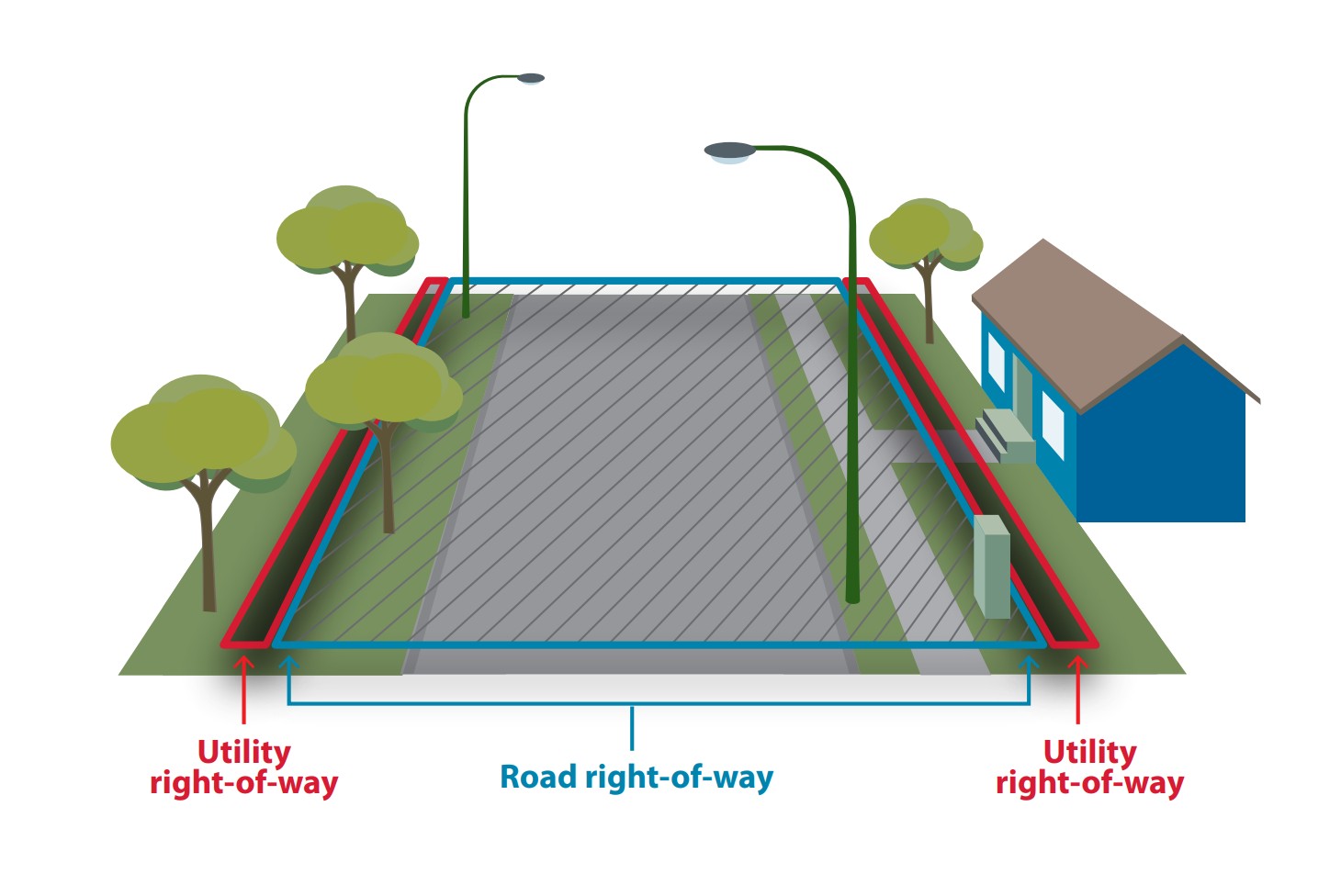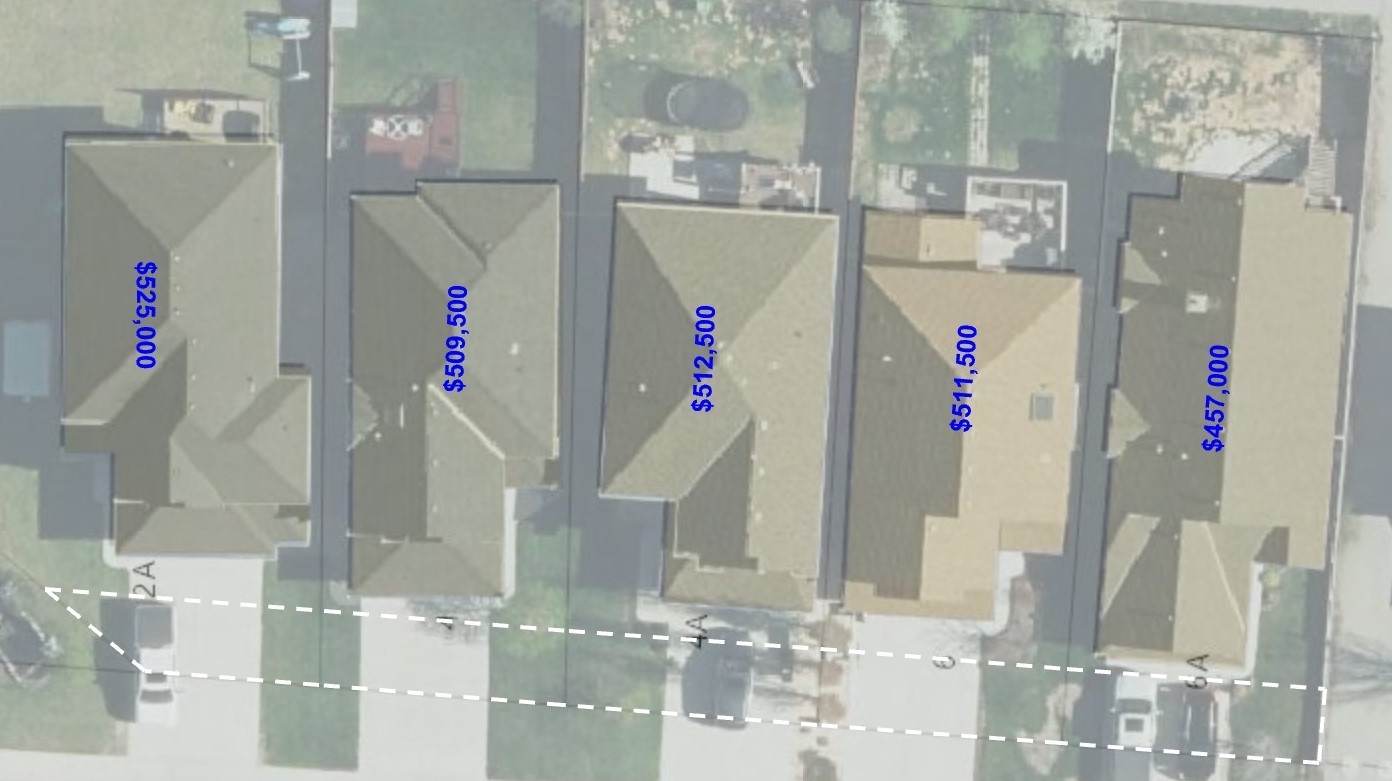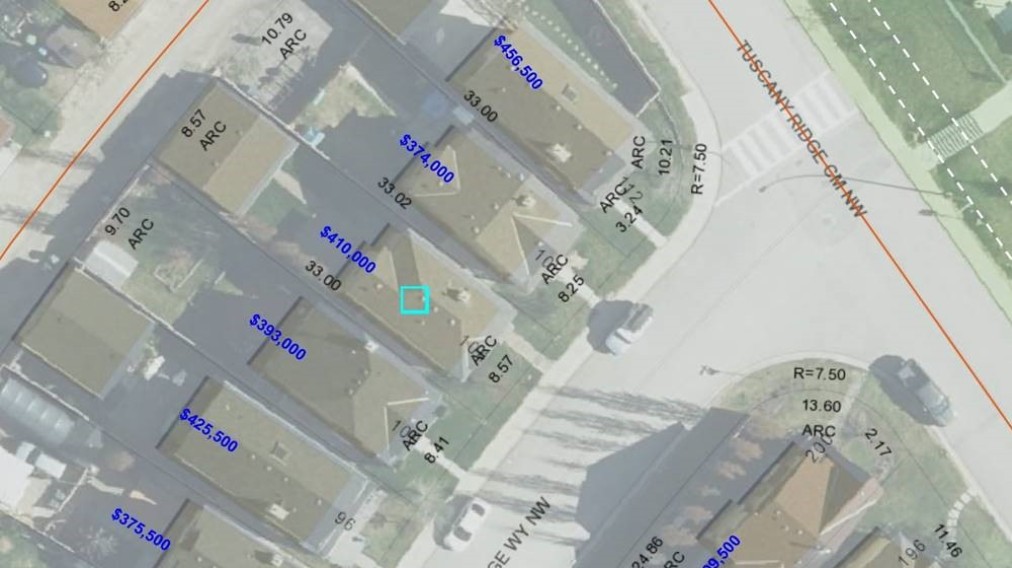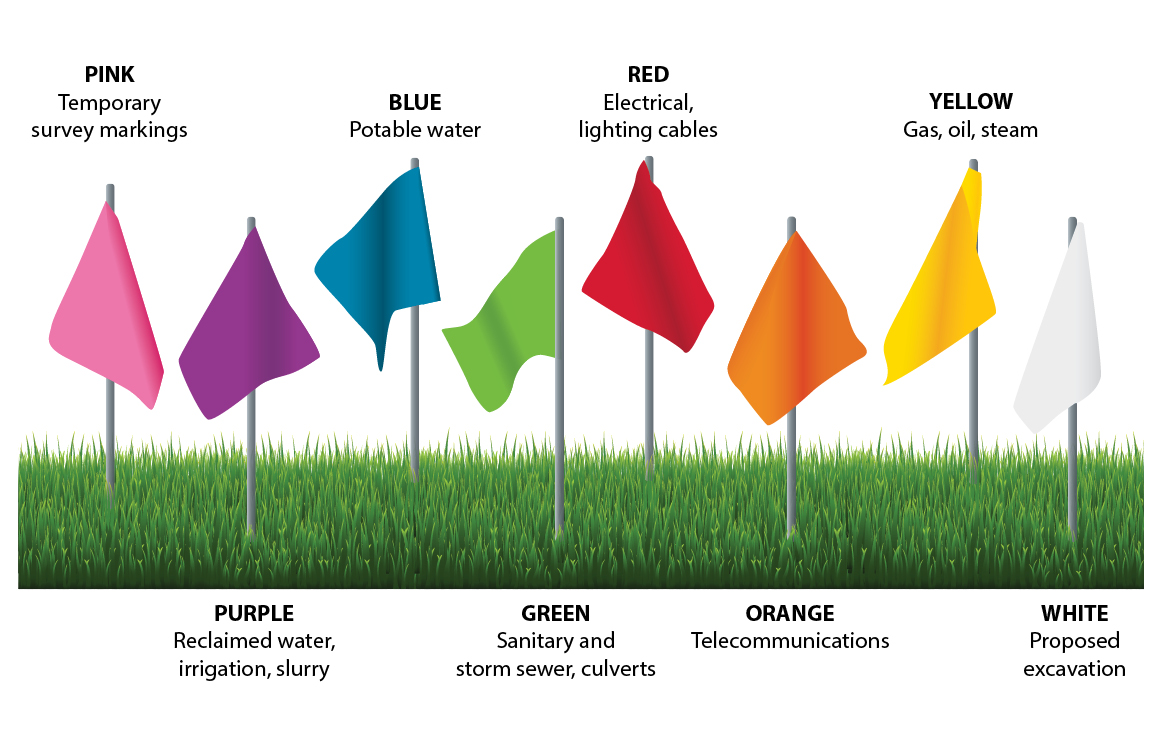Rights-of-way
Understanding rights-of-way
The City of Calgary is responsible for managing access to municipal rights-of-way in Calgary. When utility work is required in a community, crews can apply for the permits required to access the right-of-way to install infrastructure, both above and below ground. All properties contain a road right-of-way, but only some properties have a utility right-of-way on them.
Locating the right-of-way on your property
To look up where the right-of-way is located on your property, use the myProperty map link. Enter your property address to locate an aerial view of your home. White dotted lines indicate a utility right-of-way on your property. If you only see a light grey line, there is a road right-of-way, but no utility right-of-way.
Road versus utility right-of-way
There are two types of rights-of-way where utilities can be located that are managed by The City’s Rights-of-Way Management Services Group:
Here's where the road and utility right-of-way boundaries will typically be located on your property.

Road right-of-way
The road right-of-way is an area that gives The City space to do things like install street light poles and plant trees. This space gives shallow utility providers a place to build and maintain their critical infrastructure. Depending on the community, the space the right-of-way takes up in your yard will vary.
The City of Calgary uses the term road right-of-way to describe all aspects of the physical space of roads, lanes and boulevards, including but not limited to City streets and sidewalks
- Driveway crossings and wheelchair ramps
- Back lanes/alleys, and engineered walkways
- The area between the property line and the sidewalk
- The area separating roadway lanes, such as medians and islands
- The greenspace adjacent to closed/gated roads/lanes
- The area within traffic circles and roundabouts
Utility right-of-way
A Utility right-of-way is an easement granted to The City, by a property owner, which gives utility providers a place to put their infrastructure – both above and below ground. All properties contain a road right-of-way, but only some properties have a utility right-of-way on them. In most cases, the utility right-of-way starts at your property line and extends inward, toward your home. The location varies between properties and can also be located along the side of your home or at the back.
Related information
Right-of-way contacts
Questions about a right-of-way on your property or work being done?
1. Always contact the utility provider or contractor doing the work first.
2. Please contact 311 if you are unsure of who is doing the work or are unable to contact the utility provider directly.
3. Email ULAsupport@calgary.ca
Property owner responsibilities
As a homeowner, you are responsible to maintain this space. Here are some important things to keep in mind:
- Trees are not permitted to be planted in a utility right-of-way, but flowers or shrubs can be planted at the discretion of the homeowner. It is important to note that while The City or utility provider is responsible for restoring any lawn damage caused by construction, they are not responsible for replacing flowers or shrubs that have been planted in a utility right-of-way.
- Before digging holes anywhere in your yard (for fences, plants or trees), please contact Utility Safety Partners to mark the location of shallow utilities.
- As the homeowner, make sure any work being done doesn’t go against the requirements and restrictions that are registered against the property.
Always remember to call or click before you dig. For more information on this service or to submit a locate request, visit Utility Safety Partners.
Managing rights-of-way
The City works to ensure equitable treatment of utility providers and compliance with City bylaws, including but not limited to the Municipal Rights-of-Way Bylaw 17M2016 (270KB). A Utility Alignment Permit is required by any shallow utility provider in Calgary before they can access the rights-of-way. A shallow utility provider is defined as any utility provider that installs their infrastructure at a depth from 0.9m to 2m in the road right-of-way.
The City has developed guidelines for shallow utility providers to follow when working in, on and above The City’s rights-of-way. View the ROW Bylaw Guidelines.
Frequently asked questions
1. How do I know where the rights-of-way are in my yard?
All properties contain a road right-of-way, but only some properties have a utility right-of-way on them. To look up the rights-of-way on your property, click on the magnifying glass on the myProperty map and type in your address. This will pull up an aerial view of your home and show you where the rights-of-way are in your yard by looking at the white dotted lines.
If you have two dashed lines running across your property, your property contains both road right-of-way and a utility right-of-way. The dashed line that’s closest to the road denotes your property line/end of the utility right-of-way. If there is a second dashed line, that one denotes the limit of the utility right-of-way.
Another option is to review your certificate of title. Rights-of-way are usually registered on the certificate of title and are automatically transferred from one owner to another when a property is sold.

Figure 1 White dashed lines indicate a utility right-of-way

Figure 2 If there are no white dashed lines and only a light grey line, there is a road right-of-way and no utility-right-of-way.
2. Who can access rights-of-way in Calgary?
Either by way of a legal agreement, or following the terms and conditions of the Rights-of-Way Bylaw (17M20216), shallow utility providers are able to access the ROW as long as they: comply with all safety and environmental legislation, obtain consent from The City (by way of a permit) to access a specific location in the ROW, and obtain any related permits required to do the work (i.e. excavation permit, street use permit, etc.).
3. What is a shallow utility provider?
A shallow utility provider is defined as any utility provider that installs their underground infrastructure at depths ranging from 0.9 m to 2.0 m in the road right-of-way. Power, gas and telecommunications companies are the most common examples of what we call ‘shallow utilities’.
4. Do The City or shallow utility provider need permission to access the right-of-way on my property?
A Utility Alignment Permit is a requirement of any shallow utility provider, or City department before they can access rights-of-way. The application must be submitted by the appropriate utility provider (or its designate) to the Rights-of-Way Management team for review and approval before any work can commence in the right-of-way.
5. How do I know if a utility provider or one of their contractors has a permit?
Any utility providers and/or contractors working in the right-of-way are required to have the proper permits on them at the time of construction. If you ask to see their permits, they should be able to produce them for you.
6. Who is responsible for notifying the homeowner of work on their property?
There is not a mandated requirement for utility providers to alert homeowners when constructing in the right-of-way, although many do by way of things like mail notifications and neighbourhood signage. That said, if a shallow utility provider is requesting access to your private property – and not simply access to the right-of-way – they are not able to do so without your written consent.
7. Is an easement the same thing as a right-of-way?
No – a right-of-way is different than an easement. A right-of-way is public land, which can come in the form of an easement (think: utility right of way), but an easement refers to a portion of private property where the bundle of rights associated with it, have been granted to The City of manage (i.e. granting access approvals, etc.).
8. What governs how the right-of-way is used and accessed?
The City assumes the responsibility for managing access to, and the use of municipal rights-of-way, ensuring equitable treatment for all utility providers, while simultaneously ensuring strict compliance to and enforcement of all City bylaws, including but not limited to the Municipal Rights-of-Way Bylaw 17M2016.
The City has developed comprehensive guidelines to outline the requirements for shallow utility providers to work in, on and within The City’s rights-of-way and to provide for the efficient review of permit applications. View the ROW Bylaw Guidelines.
There are several agreements, bylaws and processes in place to provide governance for right-of-way management. These include:
- Municipal ROW Bylaw (17M2016)
- Municipal Consent and Access Agreements (MCAAs)
- Utility Alignment Permit (UAP) process
- Other related bylaws and policies include: Streets Bylaw; Drainage Bylaw; and Complete Streets Policy and Guide.
9. Why do rights-of-ways need to be managed?
There are three main reasons for proactively managing rights-of-way: (1) Safety; (2) consistent construction standards; and (3) responsible management of taxpayer funds.
10. What do the spray-painted markings in my yard mean and what are they for?
11. Who maintains the right-of-way?
Maintenance of the right-of-way is the responsibility of many different parties. The City requires homeowners to look after things like the care and maintenance of the portion of ROW that you would call your ‘yard’, but any utility provider who constructs in the right-of-way has a responsibility to repair and restore any disturbance their construction efforts may have caused. Likewise, The City is responsible for a lot of the maintenance associated with the condition of road infrastructure like curbs, sidewalks, etc.
12. Are shallow utilities responsible for the restoration and repair of my lawn, as a result of their construction work?
Yes. Any shallow utility who constructs in a right-of-way and disturbs any of the surface area is responsible for restoring the area, appropriately.
Once construction is complete, the utility will fill and level the impacted area, and then, in most cases, will apply a mix of loam and grass seed mix, but some utilities may use hydro seed or some other seed variety. Although the utility may come back to water the area at first, it is then the responsibility of the homeowner to water the seed and properly care for this new grass.
13. I don’t want anyone accessing my yard. Is there anything I can do?
If a shallow utility provider has the proper permits in place, they have the right to access right-of-way to install and maintain their infrastructure.



